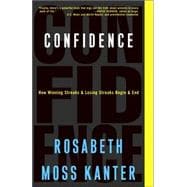
What is included with this book?
| Foreword to the Paperback Edition | xi | ||||
| Preface | xvii | ||||
| Part I WINNERS AND LOSERS: HOW CONFIDENCE GROWS OR ERODES | |||||
|
3 | (23) | |||
|
26 | (37) | |||
|
63 | (25) | |||
|
88 | (25) | |||
|
113 | (32) | |||
| Part II TURNAROUNDS: THE ART OF BUILDING CONFIDENCE | |||||
|
145 | (37) | |||
|
182 | (34) | |||
|
216 | (40) | |||
|
256 | (35) | |||
|
291 | (34) | |||
| Part III IMPLICATIONS AND LIFE LESSONS | |||||
|
325 | (25) | |||
|
350 | (21) | |||
| Epilogue | 371 | (6) | |||
| Appendix | 377 | (4) | |||
| Notes | 381 | (16) | |||
| Acknowledgments | 397 | (6) | |||
| Index | 403 |
The New copy of this book will include any supplemental materials advertised. Please check the title of the book to determine if it should include any access cards, study guides, lab manuals, CDs, etc.
The Used, Rental and eBook copies of this book are not guaranteed to include any supplemental materials. Typically, only the book itself is included. This is true even if the title states it includes any access cards, study guides, lab manuals, CDs, etc.
Excerpted from Confidence: How Winning Streaks and Losing Streaks Begin and End by Rosabeth Moss Kanter
All rights reserved by the original copyright owners. Excerpts are provided for display purposes only and may not be reproduced, reprinted or distributed without the written permission of the publisher.